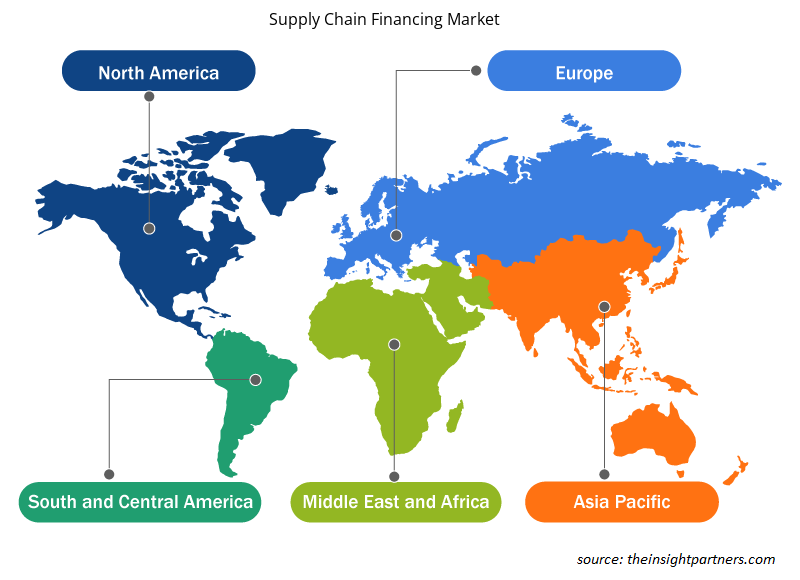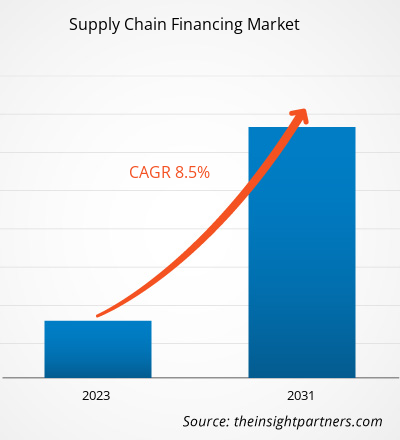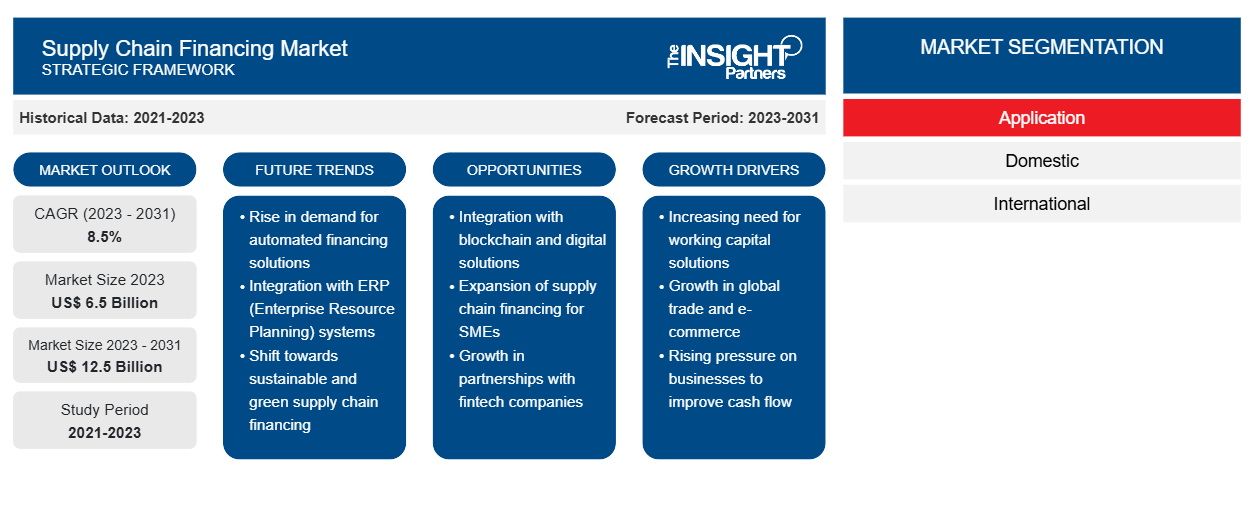供应链融资市场规模预计将从 2023 年的 65 亿美元增长至 到 2031 年将达到 125 亿美元;预计 2023 年至 2031 年的复合年增长率为 8.5%。该行业的市场增长受到多种因素的推动,包括融资成本降低和效率提高、全球化和供应链风险以及营运资本管理需求的不断增长。
供应链融资市场分析
推动供应链金融市场发展的因素有几个。首先,供应活动对安全性和保障的需求日益增长,这导致对供应链金融解决方案的需求增加。在当前的商业环境中,这种对安全性和保障的需求尤为突出,因为中断和不确定性很常见。其次,发展中国家的中小企业 (SME) 采用供应链金融也促进了市场的增长。中小企业认识到供应链金融在改善财务运营和提高竞争力方面的好处。
定制此报告以满足您的需求
您可以免费定制任何报告,包括本报告的部分内容、国家级分析、Excel 数据包,以及为初创企业和大学提供优惠和折扣
-
获取此报告的关键市场趋势。这个免费样品将包括数据分析,从市场趋势到估计和预测。
供应链融资行业概况
- 供应链融资,也称为供应商融资或反向保理,是一种为参与供应链活动的企业优化现金流和营运资金的金融解决方案。
- 它涉及一系列基于技术的流程,将买家、供应商和金融机构联系起来,以降低融资成本、提高现金流效率并降低风险。在供应链金融中,买方的信用评级通常比卖方高,这使他们能够以较低的成本从金融提供商那里获得资金。
- 这一优势使买家能够与卖家协商出更好的条款,例如延长付款期限。同时,卖家可以从中介融资机构获得即时付款,从而更快地卸下产品。供应链金融的目标是为买卖双方提供短期信贷并优化营运资本。它帮助供应商提前收到发票付款,降低供应链中断的风险并提高财务稳定性。买家受益于增加的营运资本和加强与供应商关系的能力。
供应链融资市场驱动因素
供应活动安全保障需求上升,推动供应链融资市场
- 推动供应链融资市场增长的关键因素有几个。首先,对安全和保障的需求不断增长,推动了供应链融资市场的增长。
- 由于市场操纵,供应链融资需求不断增长,其中包括投资者信心丧失、市场诚信受损、欺诈行为以及金融公司被迫投资于提供更好数据收集、监控能力和金融安全性的供应链融资方法等因素。在国际贸易的早期,出口商面临着进口商是否会支付其货物的不确定性。
- 相比之下,进口商担心在没有货物发货保证的情况下付款。供应链金融已经发展到通过向出口商提供更快的付款并通过信用证向进口商保证来应对这些风险。为了保持领先于竞争对手,供应链金融提供商正在推出更多解决方案来增强投资者界面体验。这种对供应链活动安全性的日益关注预计将为供应链融资市场预测带来新的机会。
供应链融资市场报告细分分析
根据提供内容,供应链融资市场细分为出口和进口票据、信用证、履约保证金、装运担保等。预计到 2023 年,出口和进口票据部分将占据相当大的供应链融资市场份额。这可以归因于银行在促进文件流动和向供应商付款方面的作用。在贸易融资的背景下,出口托收票据是一种出口商与银行接洽以控制文件流动及其发放的方法。出口商经常面临进口商不付款的风险,而进口商则担心在没有货物发货保证的情况下付款。供应链融资,特别是通过使用出口票据,通过加快向出口商付款并通过信用证 (LOC) 向进口商保证来解决这些风险。因此,国际贸易活动中对安全和保障的日益增长的需求预计将带来新的供应链融资市场趋势。
供应链融资市场地域分析
供应链融资市场报告的范围主要分为五个地区——北美、欧洲、亚太、中东和非洲以及南美。北美正在经历快速增长,预计将占据重要的供应链融资市场份额。全球化对企业财务和供应链风险的影响日益加剧,导致对供应链融资解决方案的需求增加。此外,远程工作和社交距离的增加给供应链融资从多个地点和来源获取数据带来了挑战。这凸显了强大的供应链融资解决方案对降低风险和确保平稳运营的重要性。
供应链融资市场区域洞察
Insight Partners 的分析师已详细解释了预测期内影响供应链融资市场的区域趋势和因素。本节还讨论了北美、欧洲、亚太地区、中东和非洲以及南美和中美洲的供应链融资市场细分和地理位置。

- 获取供应链融资市场的区域特定数据
供应链融资市场报告范围
| 报告属性 | 细节 |
|---|---|
| 2023 年的市场规模 | 65亿美元 |
| 2031 年市场规模 | 125亿美元 |
| 全球复合年增长率(2023 - 2031) | 8.5% |
| 史料 | 2021-2023 |
| 预测期 | 2023-2031 |
| 涵盖的领域 |
按应用
|
| 覆盖地区和国家 |
北美
|
| 市场领导者和主要公司简介 |
|
供应链融资市场参与者密度:了解其对业务动态的影响
供应链融资市场正在快速增长,这得益于终端用户需求的不断增长,而这些需求又源于消费者偏好的不断变化、技术进步以及对产品优势的认识不断提高等因素。随着需求的增加,企业正在扩大其产品范围,进行创新以满足消费者的需求,并利用新兴趋势,从而进一步推动市场增长。
市场参与者密度是指在特定市场或行业内运营的企业或公司的分布情况。它表明在给定市场空间中,相对于其规模或总市场价值,有多少竞争对手(市场参与者)存在。
在供应链融资市场运营的主要公司有:
- 汇丰集团
- 苏格兰皇家银行
- 花旗集团
- 摩根大通公司
- 美国银行公司
免责声明:上面列出的公司没有按照任何特定顺序排列。

- 了解供应链融资市场顶级关键参与者概况
《供应链融资市场分析》根据产品、供应商、应用和地理位置进行调查。在产品方面,市场分为出口和进口票据、信用证、履约保证金、装运担保等。根据供应商,市场分为银行、贸易融资公司和其他。根据应用,市场分为国内和国际。根据地理位置,市场分为北美、欧洲、亚太地区、中东和非洲以及南美。
供应链融资市场新闻及最新发展
在供应链融资市场中,企业采用并购等无机和有机战略。以下列出了一些近期的关键市场发展:
- 2023 年 8 月,汇丰银行对供应链金融公司 Tradeshift 进行了 3500 万美元的战略投资,这是其建立新合资公司计划的一部分。合资公司将专注于嵌入式金融服务的开发。这笔投资是更大规模融资的一部分,预计将从汇丰银行和其他投资者那里筹集至少 7000 万美元。汇丰银行和 Tradeshift 的合作旨在创建一系列数字解决方案,这些解决方案将集成到 Tradeshift 的平台和其他平台中。这些解决方案将包括嵌入贸易、电子商务和市场体验的支付和金融科技服务。合资企业将使 Tradeshift 能够在全球范围内扩展其商业商务主张,同时也允许汇丰银行在各个平台上部署创新金融服务。
(来源:汇丰银行,公司网站)
- 2023 年 9 月,汇丰与阿里巴巴集团物流部门菜鸟网络科技建立合作伙伴关系,为在线商家推出创新的数字贸易融资解决方案。此次合作旨在为在阿里巴巴旗下的天猫国际电子市场上销售的香港商家提供简化且易于访问的贸易融资流程。新方案利用实时物流信息进行信用评估,从而实现更快、更高效的贷款审批。与需要抵押品或大量财务文件的传统贸易融资流程不同,该解决方案利用菜鸟提供的全面信息(包括客户背景、实时库存和运营状态)来评估信誉。这是汇丰首次利用第三方数据进行贸易融资贷款审批。
(来源:汇丰银行,公司网站)
供应链融资市场报告范围和交付成果
市场报告《供应链融资市场规模和预测(2021-2031)》对以下领域进行了详细的市场分析:
- 范围内涵盖的所有主要细分市场的全球、区域和国家层面的市场规模和预测。
- 市场动态,例如驱动因素、限制因素和关键机遇。
- 未来的主要趋势。
- 详细的 PEST 和 SWOT 分析
- 全球和区域市场分析涵盖主要市场趋势、主要参与者、法规和最新的市场发展。
- 行业格局和竞争分析包括市场集中度、热图分析、关键参与者和最新发展。
- 详细的公司简介。
- 历史分析(2 年)、基准年、预测(7 年)及复合年增长率
- PEST和SWOT分析
- 市场规模、价值/数量 - 全球、区域、国家
- 行业和竞争格局
- Excel 数据集
近期报告
客户评价
购买理由
- 明智的决策
- 了解市场动态
- 竞争分析
- 客户洞察
- 市场预测
- 风险规避
- 战略规划
- 投资论证
- 识别新兴市场
- 优化营销策略
- 提升运营效率
- 顺应监管趋势























 获取免费样品 - 供应链融资市场
获取免费样品 - 供应链融资市场